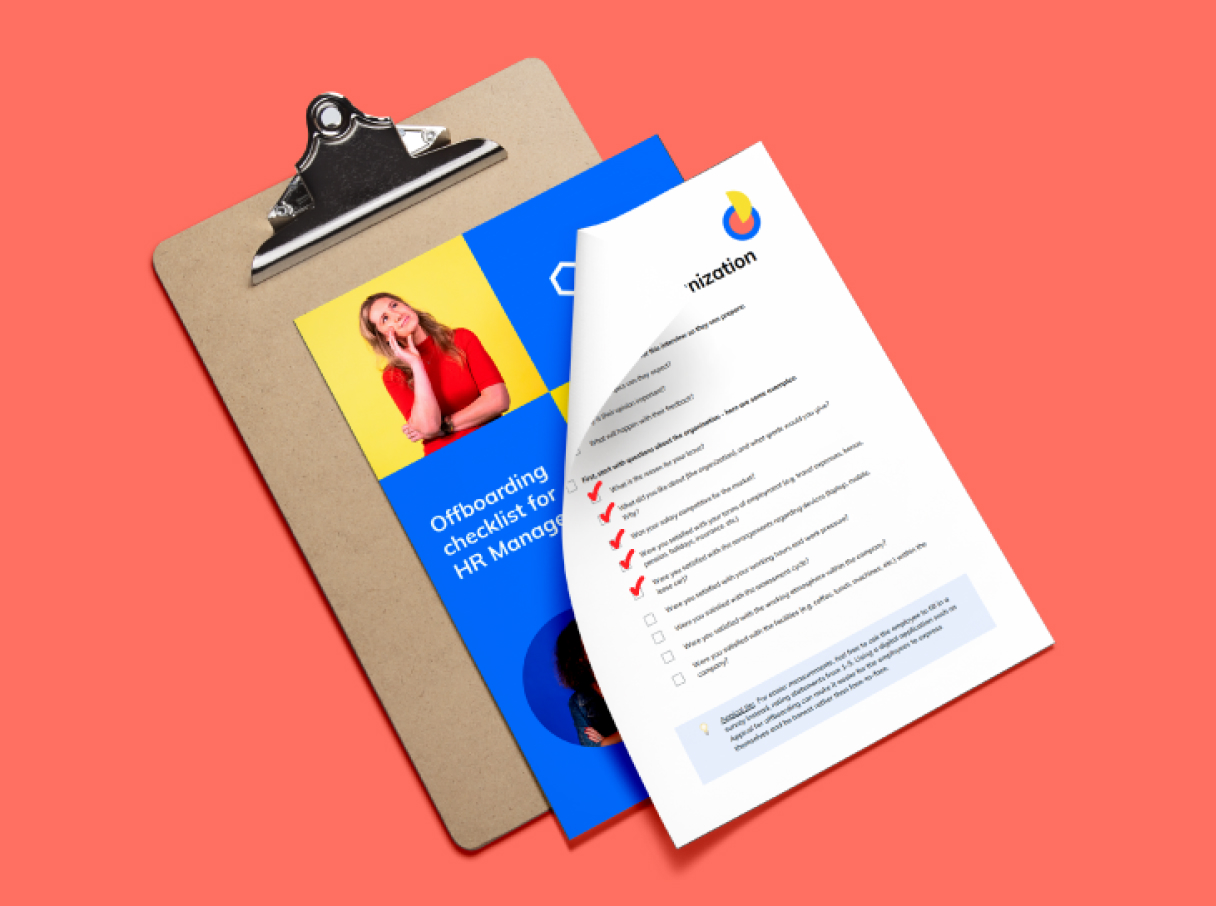
Why you should not forget your offboarding process
A study by SBI Research shows that offboarding gets around 8x less attention than onboarding. This attention is also usually limited to the transfer of knowledge to colleagues that are taking over tasks and projects, returning business property and an exit interview on the last day of work. Why is offboarding so important, and what are useful tips to start with your own offboarding program?
Showing appreciation to your employees
If your organisation offers a consistent employee experience, from beginning to end, the message is that you do what you promise. It also shows a clear signal that employees form an important part of the organisation. By spending time on an effective offboarding process you show to both current and future employees that your company appreciates their personal contribution and dedication.
Maintain a good employer's reputation
While HR nowadays spends a lot of attention on onboarding, learning & development opportunities and performance management, structuring the offboarding process often seems a lot less important.
However, offboarding is essential to maintain your organisation’s good reputation, to optimise the work experience of current and departing employees and to retain networking opportunities.
When an employee leaves, this can go two ways: either he/she becomes an ambassador for or an antagonist of your organisation. Brand ambassadors will talk about your business with pride and recommend it to their friends and acquaintances.
On the other hand, antagonists will not recommend your business and this can cause damage in the long term. The objective of offboarding is to ensure that all departing employees leave as brand ambassadors.
Also read our blog 6 steps towards good offboarding
A smooth knowledge transfer
Employees can resign for a number of different reasons, which can range from personal to professional. And of course, you also have employees that leave because they retire. Whatever the reason, departing employees can provide you with valuable information. Without a proper offboarding process, you do not have full access to their knowledge and information.
An effective offboarding process offers organisations the opportunity to minimise the chances of employees leaving and taking all their knowledge with them. A structured approach ensures that before employees leave the organisation, they transfer their specific and specialist knowledge to colleagues. Make sure there is a company-wide plan in place to transfer that knowledge to those colleagues that are going to take over his/her duties.
Other goals of an offboarding program
Why are formal offboarding programs so important? Hasn’t the employee already decided to leave the company? The goal of offboarding is not to win back the departing employee, but to:
- Ensure that the knowledge that the departing employee has is being transferred to other employees within the organisation;
- Ensure that employees leave the company on good terms. Make sure the offboarding process provides time and opportunity to discuss any problems or matters of concern, and that employees leave with a positive feeling about the organisation.
- Give you insight into how the employee perceives the organisation and what the strong and weak points are. This allows you to determine how any problems that were perceived can be improved.
- Keep the door open for ‘boomerang’ employees who may want to return at some time in the future.
Tips to start with your own offboarding program
If you want to take part in an offboarding program, these are four tips:
1. Start with an offboarding checklist 📋
Make a checklist, so you can tick off all the necessary steps in the offboarding process. Having a checklist is very useful during offboarding, as such a process usually concerns multiple stakeholders and has to be completed in a matter of a few weeks, before the last working day of the departing employee. For instance, HR has to be informed to ensure that all the necessary administrative procedures are followed and important data is recorded, IT has to know what software access rights have to be terminated or transferred, and the team supervisor has to ensure that knowledge is secured and tasks and projects are transferred to colleagues in full and on time. Having a good checklist helps to structure this process.
2. Schedule an exit interview on time; this is a valuable source of information ⏳
It sounds easy, but quite often this interview is a bit of an afterthought and done hastily on the last day of work.
However, it is much better to schedule this interview as soon as you know when the last day of work will be, to ensure that both parties can prepare for it and know what they will be talking about. If the interview is scheduled well in advance, the employee has time to reflect on his/her time with the organisation and is better able to answer questions. If you want to include a number of standard questions, you can our offboarding checklist with standard and additional exit interview questions.
3. All employees follow the offboarding program, whether they resigned themselves or are forced to leave the company
Of course this is not written in stone, but do try and treat everyone the same way. Employees that are forced out also have useful information to share and duties and tasks to transfer. In addition, they made a contribution to your company, and deserve appreciation for the work done.
4. Maintain contact with former employees who would like to stay in touch 📱
Build a network of brand ambassadors who can promote your organisation to family, friends and acquaintances who are looking for a job. In the medium term, this will result in a good flow of potential candidates. Such a network can save you money on recruitment, can be used long-term and referral candidates are usually a better match as well. A report by the Academie voor Arbeidsmarktcommunicatie, ‘The current state of recruitment 2019/2020’, indicates that referral recruitment still is the next best source of high-quality candidates. The report also highlights that of all the candidates who are hired via referral recruitment, 1 in 4 become ‘outperformers’. In other words: Make sure that your departing colleagues leave as brand ambassadors!
In summary
If you do not yet have a structured offboarding program, start developing one as soon as possible and implement this program everywhere in your organisation! Make sure knowledge is retained, projects and tasks are properly transferred to colleagues, and you compile feedback about the organisation in an exit interview. And above all: make sure the employee feels appreciated and leaves your organisation on good terms, and hopefully as a brand ambassador.
If you want more information about offboarding, check out how you can implement the offboarding process via the Appical app or read the case study about Carl Zeiss and their offboarding program.
Join 6.956 HR and onboarding specialists!
Have all our latest onboarding news delivered to your inbox. Sign up for our monthly newsletter.
Related posts
Want to know more about onboarding? See our other blogs

6 steps towards a good offboarding
We'd like to give you a few tips to create an offboarding program.

4 tools you want to use for a memorable offboarding program
We made a list of what kind of tools you need to use to offboard your employees even better.

5 reasons to focus more on offboarding your employees the right way
In this blog, we look at why organisations and departing employees should focus more on their offboarding program.